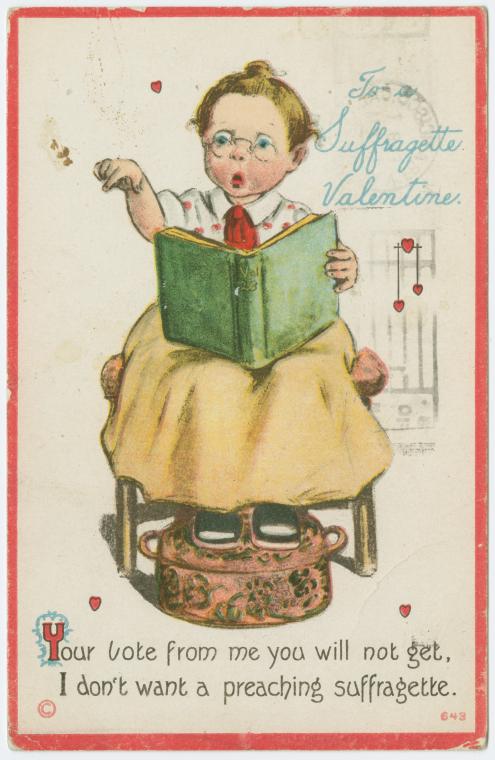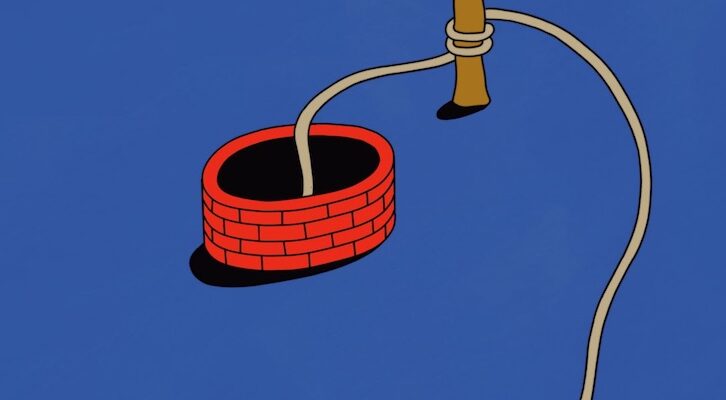The Valentine’s Day love note from a secret admirer has an evil twin—the “vinegar valentine” from a hidden hater. When mass-produced valentines replaced handmade ones in the Victorian era, satirical valentines were as available as sentimental ones. Vinegar valentines, ancestors of poison pen letters and trolls’ tweets, ridiculed their recipients and sometimes drove them to suicide or assault.
Sending cards with poems of love and friendship to mark Valentine’s Day became common in the 18th century. This practice grew out of an earlier tradition of gift-exchange between lovers on that day. In pre-Victorian England, valentines were handmade and resembled today’s cards in their depiction of flowers or other symbols of love along with sentimental verses. To avoid triteness, poetically-challenged men and women had to resort to annual pamphlets like Every Lady’s Own Valentine Writer, in Prose and Verse for the Year 1794.
Nineteenth century advances in printing and paper production took away the burden of composition, brought inexpensive cards to the market, and spread the custom of sending paper tokens of affection. After 1840, when Great Britain established the Uniform Penny Post system, sending cards became cheap, fast, and anonymous. That, along with the rise in literacy, pushed the annual number of Valentine’s Day cards sent in Great Britain from an estimated 200,000 in the 1820s to nearly eight times that many in the 1870s.
Some of that growth came from card vendors’ introduction of mocking valentines, which could go to neighbors, relatives, and colleagues in all classes and walks of life. Those cards were also available across the Atlantic. The 1847 catalog of A. S. Jordan, an American importer of British valentines, listed cards not only in such traditional categories as Romantic, Courting, and Matrimonial but also Caricature, Spiteful, Lampooning, and even Suicidal. Many people couldn’t resist putting curare on Cupid’s arrow. According to estimates, half of all valentines sent in the United States by the mid-19th century were the spiteful kind. Usually, they were printed on a single side of flimsy paper, not on folded card stock. It was cheaper to insult than to praise.
Vinegar valentines married humorous images to caustic sentiments. The typical format was a caricature of the recipient and a short verse at the bottom. Sometimes women sent anti-valentines to men who were pursuing them. In one, a woman is shown holding a huge lemon inscribed with “To my Valentine.” She extends the lemon to a miniscule man in the lower corner of the card. The verse reads: Tis a lemon that I hand you / And bid you now “skidoo” / Because I love another— / There is no chance for you! Likewise men sent vinegar valentines to damsels who’d dared turn them down or to women they were throwing over.
Even in the absence of a personal relationship, women received valentines mocking them for behavior that would drive away men. Cards derided women for frowning and also for smiling too much. A card with a finely dressed woman in an elaborate hat and a skirt made of peacock feathers reads: Proud beauty you’d best lay aside, / Your nonsense and your peacock pride, / Or none will have the pluck to say, / “Fair lady will you name the day.”
Other valentines condemned women for not dressing well enough. An illustration of an unkempt woman with a stack of books under one arm is accompanied by these words: Pray do you ever mend your clothes / Or comb your hair? Well, I suppose / You’ve got no time, for people say / You’re reading novels all the day.

Phrases like “people say” and “everyone knows” often appear in the mocking valentines. The sender thereby proclaims he is speaking on behalf of the larger community, not out of his own malice. As the women’s suffrage movement grew, so did the number of valentines lampooning women who fought for the right to vote. One of these reads: The vote from me you will not get / I don’t want a preaching suffragette.
Men were also the butt of vinegar valentines. They were criticized for drunkenness, vanity, stinginess, and stupidity. Some vinegar valentines didn’t even bother with poetry, but chided in prose: Everyone thinks you an ignorant lout or Don’t borrow money from your friends. Pitch in and earn it for yourself.
Cruel valentines poked fun at people’s physical characteristics or misfortunes, including their age, excessive weight, or widowed status. The most malicious cards suggested suicide to the recipient. The image on one of them depicts an oncoming train with the verse: Oh miserable lonely wretch! / Despised by all who know you; / Haste, haste, your days to end—this sketch / The quickest way will show you!
 Vinegar Valentine’s card, c1875.
Vinegar Valentine’s card, c1875.
Though many sentimental valentines from the 19th century have survived, offensive valentines are rare, presumably because offended recipients burned or trashed them. Some had even stronger reactions to them. In 1847 a New York City woman overdosed on laudanum after receiving a nasty valentine from a man who’d led her to believe she was his love interest. In 1885 a London evening newspaper, the Pall Mall Gazette, reported that a man was charged with attempting to murder his wife: “The pair lived apart, and on St. Valentine’s Day she sent him an offensive valentine. In his anger he purchased a revolver, and meeting his wife last night shot her in the neck. The woman lies in the hospital in a critical condition.” Reports appeared in newspapers of fighting and physical assaults resulting from a vinegar valentine’s “scurrilous lampoons” (Dundee Courier and Argus 1877).
Because of public revulsion, these valentines became less common in the latter part of the century in England. Their popularity declined a few decades later in the United States, about the time when the poison pen letter became the chosen instrument of verbal abuse. Instead of the stock verses of the valentine, the letter allowed for customized venom. In another CrimeReads article, Curtis Evans explores the rash of poison pen letters during this period: The Poison Pen Letter: The Early 20th Century’s Strangest Crime Wave.
Fast forward to our century, when the cyberbully and the troll personify the spirit behind vinegar valentines. Hate springs eternal.
Happy Valentine’s Day!
***





















